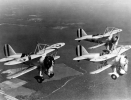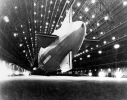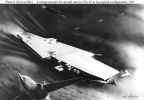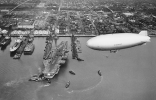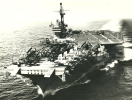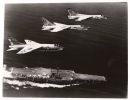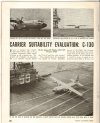Was reading through
"Neptune's Inferno" and went back to take a look at
USS Washington (BB-56) and
USS South Dakota (BB-57) Here are some photos and an account of the battle 14-15 Nov 1942, of particular note was that 5 Japanese destroyers launched a point blank spread of 34 torpedoes at the
South Dakota but all missed, likewise the
Washington dodged a spread of 32 torpedoes. Considering how much damage the Long Lance could do, the battlewagons were lucky. On the other hand, the
Washington opened up with her 16" main guns at point blank range at exactly midnight on the
Kirishima - by 00:07, the
Kirishima was a blazing wreck. Saw a good writeup of the battle and thought it should be included with the photos
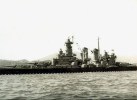
Undated port side forward broadside view of the
Washington (BB-56) at anchor, protected by an anti-torpedo net. Electronics and light A.A. armament equipment narrow this photo time frame from September, 1942 to the summer, 1943. The notch in the main deck forward is for extra anchor storage and was known as the 'billboard".

Photo taken during the battle off Savo Island showing the
Washington (BB-56) firing upon the
Kirishima on 14-15 November 1942. The low elevation of the barrels shows how the close range of the adversaries; only 8,400 yards, point blank range for the 16"/45 caliber main armament of the
Washington.
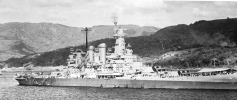 Washington (BB-56)
Washington (BB-56) after the night action of 14-15 November 1942.
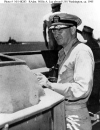
Rear Admiral Willis A. Lee, Jr., USN, Halftone reproduction of a photograph taken on board
Washington (BB-56), circa 1942-43.

Underway in the Atlantic during her shakedown period, 22 July 1942. Unique to the
South Dakota (BB-57) is the fact that she only mounted eight twin 5"/38 mounts, four to a side. The rest of the class were armed with the standard ten twin mounts. The
South Dakota was designed as a fleet flagship from the outset, so she sacrificed two 5" mounts for flag officer space
 South Dakota (BB-57)
South Dakota (BB-57) is leaving Philadelphia on 4 June 1942 for her shakedown training to 26 July
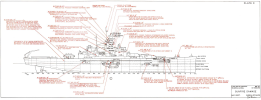
Plate No. I showing gunfire damage report inflicted on the
South Dakota (BB-57) during the battle at Guadalcanal, 14 - 15 November, 1942
PDF Action report of the Battleship Night Action between the U.S. and Japanese forces off Savo Island on November 14-15, 1942. The following text by Pieter Bakels is a summation of the battle.
At 2300 exactly on the night of 14-15 November 1942, the "SG" surface search radar of the battleship
Washington (BB-56), following the destroyers
Walke (DD-416),
Benham (DD-397),
Preston (DD-377) and
Gwin (DD-433) with another battleship astern, the new
South Dakota, began tracking a target, bearing 340T, broad on the starboard bow, distant eighteen thousand yards.
The main battery Directors of
Washington trained towards the larger of two targets, the Japanese cruiser
Sendai under the command of Rear Admiral Hashimoto. Within seconds the rangekeeper had a firing solution and
Washington's three Main Battery turrets swung to starboard, guns elevated for a range of eleven thousands yards. "Commence Firing!" was ordered at 2317 and "all hell broke loose", as
Washington blasted a nine–gun salvo at
Sendai, Hunter Cronin in Secondary Conn, ("Battle 2") wrote.
Shikinami, the second target was taken under fire by the battleship's starboard Secondary Battery directed by "Sky 3". One minute later,
South Dakota rained down shells on the destroyer
Shikinami.
Aboard
South Dakota, William P. Gray was assigned to Main Battery Fire Control Maintenance and Operations. His battle station was Main battery Director #1 as Director Captain/Pointer. He wrote in his memoirs:
"The first Main battery action, Savo Island, first sighting of enemy warships. We were ordered to pick out the biggest and commence firing. The closing of Main Battery. Firing key against enemy warships for the first time. Shells on the way and Spotting Officer calling: "No change! No change!" Her bridge and spotting personnel saw
Shikinami roll over and sink according to the Action Report.
However,
Sendai and
Shikinami retired in a loop behind a smoke screen, disappearing from view and radar in the closely confined waters of "Ironbottom Sound". When the two Japanese ships retreated behind their smoke screens, the destroyers
Walke,
Benham,
Preston and
Gwin opened fire on them and on blobs of light, coming from the direction of the shoreline of Savo Island. The Japanese had not emplaced batteries on Savo but the fire was coming from the destroyers
Ayanami and
Uranami, sent west around Savo; within their wake the cruiser
Nagara (Rear Admiral Kimura) and the destroyers
Teruzuki,
Inazuma,
Shirayuki and
Hatsuyuki. The duel was short, ferocious and uneven.
Unskilled in night fighting and saving their torpedoes for bigger stuff, the US destroyers opened up with their guns,
Gwin firing starshell to illuminate the scene. Japanese spotters used their gun flashes as fine aiming points. The destroyers
Ayanami and
Uranami each fired a torpedo spread at
Gwin but none hit. However at 2330
Walke, the lead ship, began taking hits from 5- and 5.5-inch and fell off to port and took a torpedo eight minutes later in her starboard side, blowing off the forward part of the ship. "Abandon Ship" was ordered at 2345. Depth charges rolling off their tracks and exploding, killed its Captain and many of her hands as they cleared the ship. The enemy cruisers rained down explosives on
Benham,
Preston and
Gwin and a salvo from
Nagara reduced
Preston to a wreck and on 2336 she too had to be abandoned with 116 killed.
Then
Gwin got hit, taking a pair of 5-inch shells, one in the after engine room and one on the fantail. Her guns continued firing in local control.
Benham took a torpedo in her starboard bow that blew most of it away but limped on with reduced speed, her guns firing rapidly.
Walke and
Preston were enveloped in fire, their crews struggling in the oily water in the path of
Washington and
South Dakota. At 2333 the
South Dakota went blind and deaf due to a circuit overload and steamed on behind
Washington towards the crippled
Benham.
Ray Hunter on
Washington's bridge, hearing that all communication with
South Dakota had been lost, watching the burning remains of
Walke and
Preston ahead and hundreds of men swimming about, told the helmsman: "come left!" his exact words he later wrote. He then straightened out on a parallel course to the one they were steaming. Leaving the burning destroyers to port and keeping them between
Washington and the enemy, he avoided being silhouetted by the fires, an easy target. Dozens of men could be seen in the burning water, clinging to wreckage and life rafts were thrown at them.
South Dakota, silent now for three minutes, didn't follow in
Washington's wake but sheered off to starboard of the sinking destroyers and presented an excellent silhouette. At once, Hashimoto and Kimura's searchlights illuminated the
South Dakota's superstructure.
Nagara and four destroyers launched a spread of thirty-four torpedoes at point-blank range but none found their mark.
Washington's 5-inch mounts shot out the lights and took
Nagara under fire and when her lights went out, switched fire to the accompanying destroyers, illuminating
South Dakota.
South Dakota began taking hits topside.
Savo Island's land mass made radar tracking difficult and the flashless powder that the Japanese used provided only small aiming points.
South Dakota now had restored part of her electrical power and her guns were firing, but she was still unable to communicate with
Washington.
Arthur A. Aldred's battle station was at the starboard 40mm quad on the fantail. Early in the action the 40mm crew was ordered to take cover forward of the # 3 16-inch turret because it was going to train around and fire at a target directly astern. He had just taken cover when a salvo was fired and instantly the fantail was ablaze. The muzzle blast had demolished and ignited the three Kingfisher catapult planes. "Had we not taken cover", he wrote, "most of us would have suffered the same fate." The Japanese now had a new aiming point and their fire came in fast. The next 16-inch salvo blew the burning Kingfisher overboard.
At 2340 Admiral Kondo with his main body came up with two destroyers, the cruisers
Atago and
Takao and the Battleship
Kirishima.
Washington had a fire solution for the biggest target,
Kirishima within seconds but checked fire, afraid to hit
South Dakota, last seen somewhere aft to starboard. At 2345
Benham and
Gwin, making best speed were ordered to retire out of the way. At 2355 fire was resumed.
Kondo's ships tracked
South Dakota, passing inboard of the smoldering
Walke and illuminated her again. Two destroyers launched a torpedo attack but none hit. The Japanese gunners on
Kirishima,
Atago and
Takao at a range of fifty-eight hundred yards did and
South Dakota took multiple hits in her superstructure and topside damage was considerable.
South Dakota replied with her 16-inch and hit
Atago and
Takao. However, within five minutes her radar plot was destroyed, radio communication was out and four out of six fire control radars. The #3 16-inch turret had taken a 14-inch hit outboard of the roller path and locked in train. Gunnery stations took casualties, small fires raged in the upperworks and oil was leaking from a ruptured fuel line.
Washington's location was not known to her, according to her reports and it was decided to withdraw to the rendezvous assigned by the Task Force Commander prior to the engagement. She had suffered forty-two hits, thirty-eight men were dead and sixty wounded. Just before midnight a target, first thought to be a cruiser, illuminated
South Dakota. The target was
Kirishima, broad on the
Washington beam, at a point-blanc range of eighty-four hundred yards.
At exactly midnight permission was given to open fire.
Washington's nine-gun salvo straddled
Kirishima while her Secondary Battery began firing star shells. A hit was reported on the enemy's superstructure and the third 16-inch salvo landed squarely amidships, causing bright explosions.
South Dakota was still under fire from
Atago and
Takao and
Washington's 5-inch mounts were directed against the two cruisers and shot out their searchlights, placing hits on superstructures and fires broke out on
Atago.
Washington's turn to the left had made her invisible in the loom of Cape Esperance, taking the Japanese by surprise. A report was received from Sky Control that the big target was sunk and fire ceased for ninety seconds.
Kirishima checked her fire on
South Dakota, leaving her to the other Japanese ships and trained her turrets towards
Washington.
The first salvo was a short, short, over and over. Their second salvo: over-short-on. The Japanese, steaming parallel to
Washington launched another torpedo spread and thirty-two separate reports of tracks were sent to
Washington's bridge, one of them probably hit the debris from a sinking destroyer and blew up.
Kirishima,
Atago and
Takao had altered course 180 degrees and were now steaming away from
Washington, north-eastwards, broad on the starboard quarter.
Washington resumed fire and hit
Kirishima, smothering her with fire from both 16-inch and 5-inch. One by one her turrets were knocked out. Finally only the after turret continued firing and she began to glow dull red amidships, brightening up as she took more hits. At 0007
Washington, left alone, fired the last salvo at
Kirishima, now a mass of flames with her underwater hull damaged by near misses, taking on water and listing to starboard. Out of control and her steering gear shot away, she was steaming in circles.
"Cease fire" was given for the 5-inch guns since they had reached the limit of after train. There were still multiple targets, but doubt still existed on the whereabouts of
South Dakota and
Washington's surface search radar could not see astern.
Unable to contact
South Dakota,
Washington steamed on alone. After steaming five miles on course 340T, radar reported contacts off the port bow. They were the destroyers
Kagero and
Oyashio launching a spread of torpedoes.
Washington, sighting their smoke screen, reversed course 180 degrees at twenty-six knots, throwing up an enormous wake. She needed a good two minutes to settle in on her new course during which various lookouts spotted torpedo tracks, four or five of them very close and exploding in
Washington's wake. At 0044 Admiral Lee ordered
Washington to steer generally southwest and she zigzagged back and forth on her base course, spotting another torpedo blow up in her wake.


